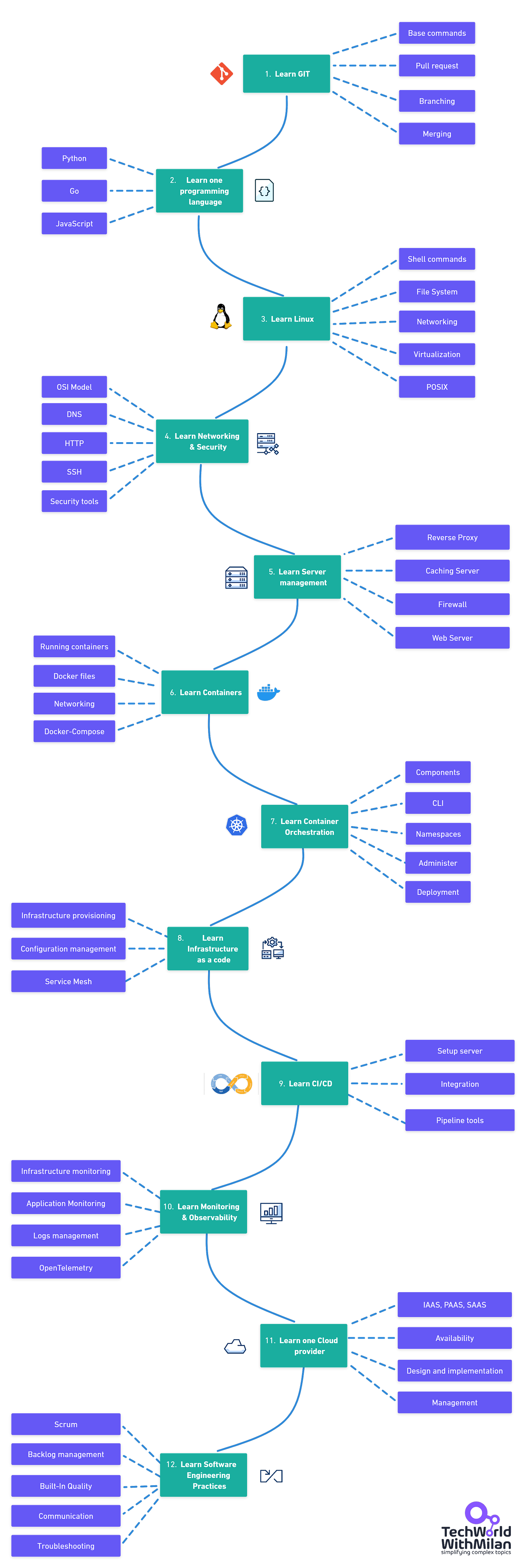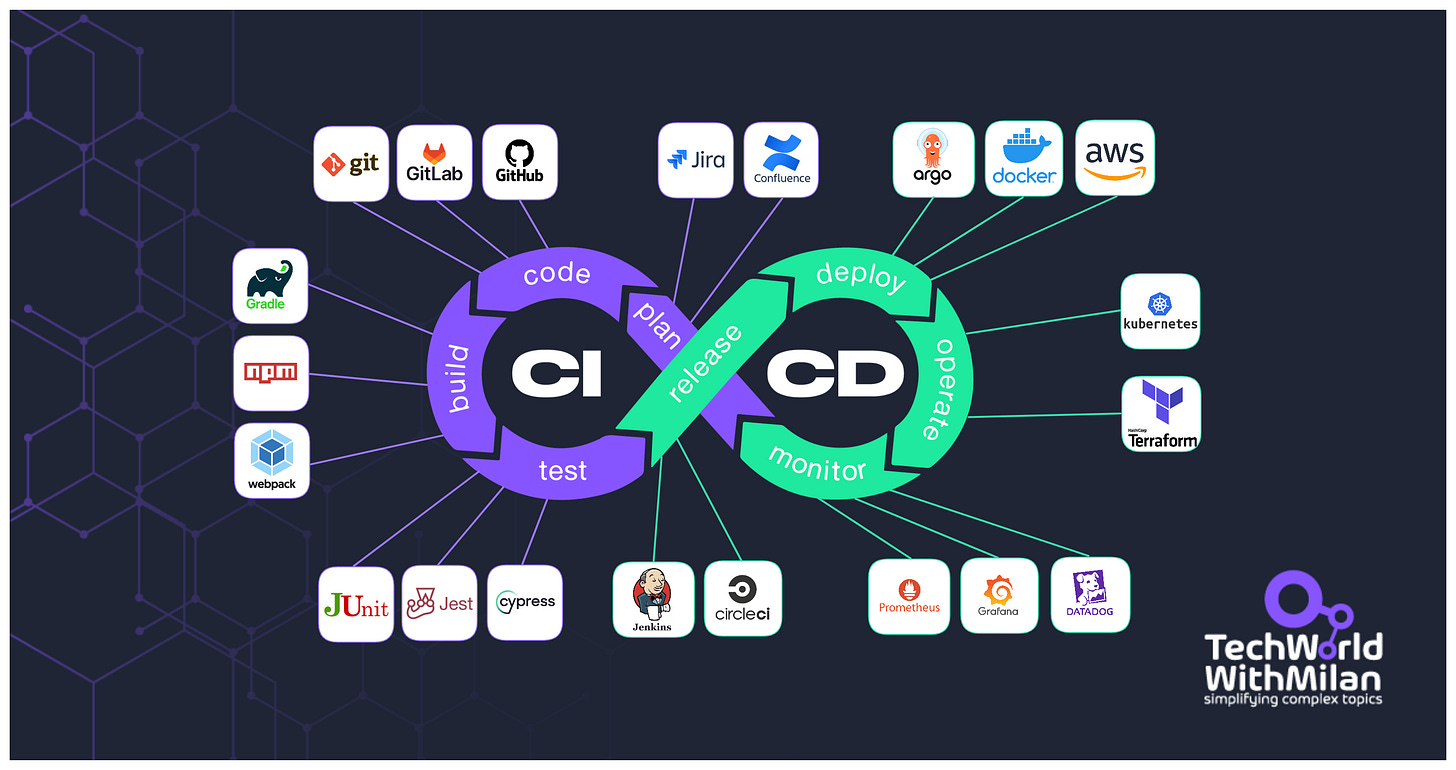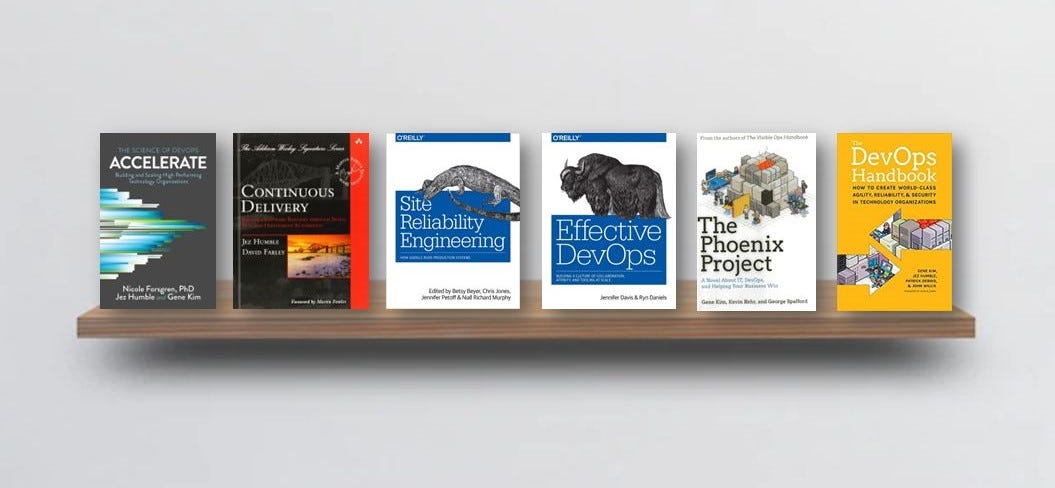DevOps Roadmap 2023.
with learning resources
This is a step-by-step guide on how to become a DevOps engineer in 2023, with links to relevant learning resources. In the path below, we can see a DevOps Roadmap for someone who would like to learn more about DevOps:
1. GIT
All your resources (files) will be held in a GIT repository. Those files are application code but also infrastructure as a code.
Git is a free tool used for source code management. Git is used to tracking changes in the source code, enabling multiple developers to work together on non-linear development.
The two most popular Git platforms are GitLab and GitHub.
Here you need to learn Git commands, like git clone, branch, merge, and how to collaborate on a project with pull requests.
Resources:
2. Learn one programming language
As an engineer, it is recommended to know at least one programming language that you can use to write automation scripts.
Some popular programming languages for DevOps-es are Python, Go, and JavaScript.
Python is a multi-paradigm language. Being an interpreted language, code is executed as soon as it is written, and the syntax allows for writing code in different ways. Python is frequently recommended as the first language new coders should learn, because of its focus on readability, consistency, and ease of use.
Here you need to learn basic concepts of programming languages, such as syntax, if/else, loops, data structures, etc.
Resources:
Eloquent JavaScript, 3rd edition, Marjin Haverbeke
3. Learn Linux & Scripting
An Operating system serves as a bridge between a computer's user and its hardware. Its function is to offer a setting in which a user can conveniently and effectively run programs.
As most servers use Linux OS, you need to make yourself comfortable with Linux and its CLI.
One easy-to-start distribution is Ubuntu.
In addition, you need to know scripting to automate tasks for development and operations.
Here you can learn OS-specific languages, such as Bash or Powershell, or independent, like Python or Go.
Resources:
4. Learn Networking & Security
A network protocol is an established set of rules that determine how data is transmitted between different devices in the same network. Essentially, it allows connected devices to communicate with each other, regardless of any differences in their internal processes, structure, or design.
Here you will need to know how a network works, how to configure firewalls, understand how DNS works, OSI model, IP addresses, ports, etc.
Resources:
5. Learn Server Management
Server management includes all the infrastructure monitoring and maintenance required for servers to operate reliably and at optimal performance levels. The primary goals of an effective server management strategy are to:
Minimize server slowdowns and downtime while maximizing reliability.
Build secure server environments.
Scale servers and related operations to meet the needs of the organization over time.
Here you will need to know what is forward and reverse proxies, caching servers, and how to operate Web Servers, such as Nginx, Apache, or IIS.
Resources:
6. Learn Containers
A container is a standard unit of software that packages up code and all its dependencies, so the application runs quickly and reliably from one computing environment to another.
Docker is by far the most popular container technology today. A Docker container image is a lightweight, standalone, executable package of software that includes everything needed to run an application: code, runtime, system tools, system libraries, and settings. Here you need to know how to run containers, Docker Networking, Volumes, Dockerfiles, and run multiple containers with Docker-Compose.
Resources:
7. Learn Container Orchestration
Container orchestration automates the deployment, management, scaling, and networking of containers.
Container orchestration can be used in any environment where you use containers. It can help you to deploy the same application across different environments without needing to redesign it. And microservices in containers make it easier to orchestrate services, including storage, networking, and security.
Here you need to learn how Kubernetes works, and how to administer the Kubernetes cluster and deploy applications on it.
Resources:
Kubernetes Crash Course for Absolute Beginners by TechWorld with Nana
Primer: How Kubernetes Came to Be, What It Is, and Why You Should Care
Certified Kubernetes Administrator (CKA) with Practice Tests
Understand when to use Cluster Services, Ingresses or API Gateways
Understand which Problems Service Mesh solve (Use an Abstraction smi-spec.io
Kubernetes Learning Path - 50 days from zero to hero from Microsoft
8. Learn Infrastructure as a code
Sometimes referred to as IaC, it refers to the techniques and tools used to define infrastructure, typically in a markup language like YAML or JSON. Infrastructure as code allows Engineers to automate environment setup and teardown. Accelerates and de-risks deployment by provisioning gold copy environments on demand.
Terraform is the most popular infrastructure provisioning tool, but there are others such as Ansimble, Chef, Puppet, and Vagrant.
Here you need to know how to do infrastructure provisioning and configuration management.
Resources:
9. Learn CI/CD
Continuous Integration / Continuous Deployment (CI/CD) is a method to frequently deliver apps to customers by introducing automation into the stages of app development. CI/CD is a solution to the problems integrating new code can cause for development and operations teams.
CI/CD introduces continuous automation and continuous monitoring throughout the lifecycle of apps, from integration and testing phases to delivery and deployment. These connected practices are often referred to as a "CI/CD pipeline" and are supported by development and operations teams.
There are different stages of a CI/CD pipeline, such as: build, test and deploy, but there could be much more activities included:
Checking code from version control and building it
Having staged gates for different kinds of approvals
Managing environment variables
Restarting services
Executing tests
And more...
Here you need to learn how to set up CI/CD server, integrate code and trigger pipelines automatically, and build and package management tools.
Some popular CI/CD tools are Jenkins, TeamCity, CircleCI, Bamboo, GitLab, and Azure DevOps.
Resources:
10. Learn Monitoring & Observability
Monitoring entails overseeing the entire development process from planning, development, integration and testing, deployment, and operations. It involves a complete and real-time view of the status of applications, services, and infrastructure in the production environment.
This is especially important when our software is in production, and we need to track all kinds of issues in our infrastructure and application.
The two most popular tools are Prometheus and Grafana.
Here you need to know how to set up monitoring and visualize data.
Resources:
11. Learn one Cloud provider
Cloud providers provide a layer of APIs to abstract infrastructure and provision it based on security and billing boundaries. The cloud runs on servers in data centers, but the abstractions cleverly give the appearance of interacting with a single "platform" or large application. The ability to quickly provision, configure and secure resources with cloud providers has been key to both the tremendous success, and complexity, of modern DevOps.
The most popular cloud providers in the market are AWS and Azure, as well as Google Cloud.
Here you need to know how to manage users and administration, networks, virtual servers, etc.
Resources:
12. Learn Software Engineering Practices
As a DevOps engineer, you will probably work in a team with other developers in an Agile world, such as Scrum. So, it is very important to know different parts of SDLC, as well as the tools which are used there.
In addition, it would be good to know how automation testing is working, as you will need to set up it in CI/CD way.
Here you need to know what is Scrum, all phases of SDLC, how automation testing works, etc.
Resources:
Additional resources
Tools
Work Tracking: Asana, Monday, Jira, Trello, Azure Boards.
Source code control: Git, Github, GitLab, BitBucket, Azure DevOps.
CI/CD: Jenkins, Team City, Github Actions, Travis CI, Bamboo, Circle CI, Azure Pipelines, Octopus Deploy, Harness, CloudBees CodeShip.
Artifact management: Artifactory, Docker Container Register, npm, Yarn, NuGet.
Container orchestration: Docker, Kubernetes, Red Hat OpenShift.
Monitoring: Prometheus, Grafana, Splunk, Dynatrace, Kibana.
Books
The DevOps Handbook: How to Create World-Class Agility, Reliability, and Security in Technology Organizations, Gene Kim, Patrick Debois, John Willis, Jez Humble
The book introduces product development, quality assurance, IT operations, and information security. It is a great read for those who are new to DevOps or who want to learn more about how the various components of DevOps work together.
Accelerate: The Science of Lean Software and DevOps: Building and Scaling High Performing Technology Organizations, Nicole Forsgren, Jez Humble, Gene Kim
This book presents both the findings and the science behind measuring software delivery performance. For promoting DevOps to senior management, it's a fantastic tool.
Continuous Delivery: Reliable Software Releases through Build, Test, and Deployment Automation , Jez Humble, David Farley
It introduces automated architecture management and data migration. Many of the deployment pipeline concepts that have since become standard were established in this book. Config as Code, build and deployment automation, and efficient testing techniques are covered in some technical detail. Its mostly technical book.
Team Topologies: Organizing Business and Technology Teams for Fast Flow, Matthew Skelton, Manuel Pais
The book talks about how to organize teams in a way that enables fast flow of value to customers. It provides a set of four fundamental team topologies: Stream-Aligned Teams, Enabling Teams, Complicated-Subsystem Teams, and Platform Teams, which can be combined and adapted to suit different organizational contexts.
Effective DevOps: Building a Culture of Collaboration, Affinity, and Tooling at Scale, Jennifer Davis, Ryn Daniels
The book provides effective ways to improve team coordination. It shows how to break down information silos, monitor relationships, and repair misunderstandings that arise between and within teams in your organization.
The Phoenix Project: A Novel about IT, DevOps, and Helping Your Business Win, Gene Kim, Kevin Behr, George Spafford
It is a classic novel about effectiveness and communications. IT work is like manufacturing plant work, and a system must be established to streamline the workflow. One of the best books out there.
Site Reliability Engineering, Betsy Beyer, Chris Jones, Jennifer Petoff, Niall Richard Murphy
This book explains the whole life cycle of Google’s development, deployment, and monitoring, and how to manage the world’s biggest software systems (also known as SRE). Anyone who considers themselves to be more on the "Ops" end of the DevOps side or who wants to know how to strengthen the bonds between various Dev and Ops teams should read SRE.
For more details, check the living repository for this DevOps Roadmap: https://github.com/milanm/DevOps-Roadmap.





Excellent article
Thank you very much